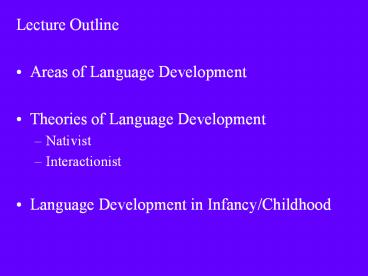Lecture%20Outline - PowerPoint PPT Presentation
Title:
Lecture%20Outline
Description:
Lecture Outline Areas of Language Development Theories of Language Development Nativist Interactionist Language Development in Infancy/Childhood – PowerPoint PPT presentation
Number of Views:129
Avg rating:3.0/5.0
Title: Lecture%20Outline
1
- Lecture Outline
- Areas of Language Development
- Theories of Language Development
- Nativist
- Interactionist
- Language Development in Infancy/Childhood
2
- Phonological Development
- Acquisition of knowledge about the sound system
of a language
3
- Syntactic Development
- Learning the rules for combining words in a
language - Ex Englishmany rules related to word order
4
- Semantic Development
- Learning the system for expressing meaning in a
language - Ex learning what words mean
5
- Pragmatic Development
- Acquiring knowledge about how language is used
(cultural rules) - Ex turn-taking
6
- Nativist Theories (Chomsky)
- Language Acquisition Device (LAD) Innate set of
rules common to all languages (universal grammar) - Unique to humans
7
- Evidence Consistent with Nativist Theories
- Children master language with little explicit
training - Non-human primates require extensive training to
master the most basic language skills - Although some non-human primates may combine
symbols, dont show evidence of using syntax
(rules)
8
- Evidence (cont)
- Certain areas of the brain appear to be
specialized for language - Left hemisphere of cerebral cortex
- Hemispheric specialization present in
infancysuggests that innate biological factors
are involved in language development
9
- Evidence (cont)
- Appears to be a critical period for language
acquisition - Critical period Time during which language is
easily acquired and after which language
acquisition is more difficult and less successful - Suggests that innate biological factors are
involved
10
- Evidence for critical period
- Brain damage more likely to result in permanent
language impairment if it occurs in adulthood
than in childhood
11
- Less hemispheric specialization occurs when a
second language is learned at 4 years or older
than if learned earlier - Knowledge of grammar is related to the age at
which individuals begin learning a second
language, not the length of their exposure to the
language - Individuals exposed earlier show greater
knowledge
12
- Evidence (cont)
- Congenitally deaf children whose parents are not
proficient in sign language - Develop larger vocabularies (gestures) than their
parents - Spontaneously impose syntax (grammatical
structure) when signing
13
- Criticisms of Nativist Theories
- Universal grammar common to all languages has not
been identified - Focus on syntactic development and neglect other
aspects of language development - Ignore role of social environment in language
development
14
- Interactionist Theories
- Children are motivated to communicate with others
- Children pay attention to clues available when
language is used - Helps them to learn language
15
- Evidence Consistent with Interactionist Theories
- Children use a variety of strategies to learn the
meaning of new words
16
- Fast Mapping
- Process of rapidly learning a new word when a
familiar and unfamiliar word are contrasted - Ex chromium and red
17
- Whole-Object Assumption
- Expectation that a novel word refers to a whole
object (rather than a part or other aspect of the
object) - Ex Cat refers to whole cat, not its whiskers
or other parts
18
- Mutual Exclusivity Assumption
- Expectation that a novel word applies to an
unfamiliar object - Ex Show me the blicket
19
- Linguistic Context
- Grammatical form of a novel word influences
childrens interpretation of it - Ex sibbing vs. a sib vs. some sib
20
- Syntactic Bootstrapping
- Inferring the meaning of a word based on the
grammatical structure of the sentence in which it
is used - Ex The duck is kradding the rabbit
- OR
- The duck and rabbit are kradding
21
- Pragmatic Cues
- Aspects of the social context that are used to
infer the meaning of words - Direction of gaze
- Intentionality
22
- Criticisms of Interactionist Theories
- The rules involved in language are too complex to
be learned simply through paying attention to
clues available in language - Especially true for syntactic development































